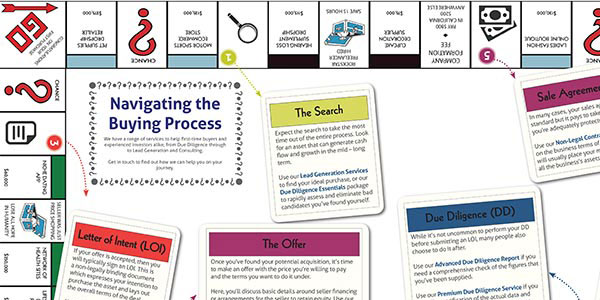The Dangers of Multiple Brokers
Categories: Buying Web-based Businesses, Marketplaces and Brokersby Justin Gilchrist, Q4 2014

(This post was originally published on Flipfilter.com. Head over using this link to see the comments)
Every morning I wake up, get out of bed and think to myself “working in this industry is like running a gangland empire”.
The fame, the money, the jewels …. actually, it’s nothing like being a kingpin, but every now and again there is a feud – or at least a very heated debate and an angrily worded letter. Thankfully, no one gets shot in the ‘internet acquisition game’ … yet.
I recently read a post by Mark Daoust from Quiet Light Brokerage entitled “The Danger of Multiple Averages”. I know Mark relatively well and he is in my opinion, one of the best brokers operating today and a great guy to talk with. … In fact, before getting to the post and what followed, I’ll give you some background to explain where this all started.
Two months ago I wrote and published the 2014 Website Buyer’s Report. It lists data, average multiples, asking prices and sample sales from 100s of websites and internet businesses sold across seven categories. The goal was to create a resource that buyers or sellers could use to get a better understanding of prices in this industry and where those prices are heading (spoiler alert .. they’re trending upwards).
This report has had lots of downloads in a short time span, and seems to be well received. I received an email from Mark who didn’t entirely agree with the conclusions that the numbers pointed towards. In his opinion and experience, the numbers were generally too low.
He published his reasons in the above mentioned post, and initially I was inclined to agree. Somehow though, the more I read the more I began to see holes in some of his logic.
The danger with multiple averages
If you haven’t read the post yet I’ll summarize Mark’s argument:
- The sample size wasn’t comprehensive enough for proper segmentation
- A heavy focus on multiple averages would cause really strong businesses not to enter the market
- Businesses with more value will always command a higher multiple (no argument there)
- The report should have included multiple ranges not category based multiples – for example, rather than telling you the average lead generation site sold for 2.69x net, it should have been listed as 0.98x – 5.83x net
- The consequence of the report is that ‘Good Businesses Aren’t Entering the Market’ ( … a little harsh pinning that one on my report … can’t we just agree to blame the economy like everyone else?)
This summary doesn’t do the post justice so please read it in full at some point –it’s well worth the read.
I didn’t disagree with everything Mark said. In fact, I agreed with more than half of it, but in many cases I had reasons for doing what I did.
For example, I totally agree that the sample size was relatively small (approx 700 listings), but this was just what was available when you took away the ones that didn’t fit the initial criteria, didn’t have complete information or were an obvious scam / misrepresented listing. The last part alone introduces some qualitative bias to the sample, but I still think the amount of listings analysed were sufficient enough to draw good conclusions on.
I also agree that a distressed business will sell for significantly less than one that shows strong performance so in this case an average can be misleading. However, by that same token the distressed business is only distressed because it shows poorer performance relative to the majority of other businesses available (i.e. the average), and the same goes for the strong performers. These are not typical businesses in any case, and not what I’m trying to represent with an average multiple – on the contrary, the average multiple is for the ‘average’ business, and I’m sure readers are smart enough to realise that without being told.
That common mistake which smart people frequently make
Mark compares two listings that are identical in every respect except earnings and states that one would fetch a higher multiple than the other.
No disagreement here.
A business with $10K annual earnings would never command as much as one with $750K but that is as much about the price bracket it will end up in rather than the qualities of the business.
The Website Buyer’s Report exclusively looked at sites that sold for above $20K, but the median and average for both was around $180K across the range. Small sites operate in their own eco-system with very different valuations to larger, more established businesses, but fortunately only a few of the sites in our sample was actually this small.
More importantly though, Mark made an intelligent argument but forgot to check if the real world supported that view.
In theory, I would expect the two businesses in the example above to sell for very different multiples mostly for the reasons he gave even if the lower end business had revenues of say $50K rather than $10K.
In practice, that’s actually not the cause based on what happened in 2013. The overall size of a business had relatively little effect on its selling multiple when we looked at the overall sample. I’ll agree that this doesn’t tell us whether those businesses were ‘bad’ or ‘good’ ones, but with a large enough sample it should even out.
My theory is that it comes down to economics
It’s a fact that demand massively outstrips supply in this industry.
This is causing prices to rise higher where the gap between demand and supply increases. How many people do you think are able to afford a $3 million purchase versus those able to afford a $300K one? Businesses that fall in the awkward price bracket between broker and private equity will often sit unsold for months, while the buyer waits for a strategic purchaser to come along.
Those priced at $100K – $300K will sell quickly if it’s a good business, even if the multiple is relatively high. There are far more competing buyers at this price range and many are baby-booming first-time buyers with a long term view for their investment. Multiples are important to them, but finding a stable investment is more important.
Mark also failed to account for the fact that not every buyer is savvy enough to spot what that good purchase is. Brokers make the mistake of assuming that a higher spend (and greater net-worth) equates to more financial savvy, but in reality it’s not the case. I blame the lottery, property booms and second-generation wealth, but I personally know investors with seven figure amounts to spend who can’t read a balance sheet.
Scatter What?
Mark also thought it would have been better to use Multiple Ranges and Scatter plots, but I’ve got to disagree with this too.
First, a multiple range just wouldn’t be useful and actionable to the average person reading.
For example, I can either tell a first-time buyer that the average content site was listed for a multiple of 2.69x last year, or I can tell them the average range content sites were listed at was 0.98x – 5.83x.
The latter is technically accurate, but put yourself in the shoes of a first time buyer and tell me which you think is more useful? Personally, I’d rather have a figure than may be 20% too high or too low but still in the same ballpark than have to decide whether I should be paying $94K or $583K for that site I’m about to buy.
He also claims “Even more helpful would have been the inclusion of scatter plots for each category”
To quote Mark,
Data sets do not always congregate nicely around the average, and sometimes an average is actually the result of two or more groupings within a dataset. … In addition to offering a simple range of multiples and scatter plots, why not include a few advanced metrics for buyers? Analysis such as standard deviation, variance, kurtosis, or a coefficient of determination would all be helpful statistics.
Here’s the example he created for us
I’m not here to underestimate or assume anything about the statistical knowledge of my average reader. I simply write at a level which I would be comfortable reading myself. My guess is the inclusion of those lovely scatter graphs, other than being visually nice to look at, wouldn’t have helped in conveying where the market was currently at. In fact, providing more data would have probably caused more confusion or misinterpretation in answering the question “is this a fair price to ask / pay”.
Where these graphs are useful is showing extreme examples like above, when a massive divide exists between two groups of data. However, using real figures, and not the fictional examples above, the graphs just didn’t paint that clear a picture.
Missing the Point
The primary goal in creating the Website Buyer’s Report was to give people who buy and sell websites and internet businesses an understanding of what’s typical given an average scenario. People can then use their own judgement to work out how far above or below ‘typical’ their particular case is, and how far to deviate from the average in light of that.
If people switch off because the information is too technical or theoretical then it’s failed its purpose of delivering a message to the reader, no matter how technically correct it happens to be. If the most technically accurate information was the best approach, Infographic designers would have gone out of business a long time ago and the most viral business posts would be spreadsheets and tables but that’s not the case.
I loved every part of designing the WBR but it took a lot of time to create and write what’s there. Given the choice and all the time in the world, the best option would have been to dig into each business, report on their ‘health’ and create new segments other than Business Model / Category that showed people how lower value sites compared to higher value ones or how older sites were valued against newer ones, but that wasn’t practical. In my opinion, it was better to publish something even with a basic metric such as average multiple, rather than do nothing and wait for someone else to provide that information to buyers.
Gunfight anyone?
There is one way to test a data study – apply it to a real world scenario and see if you can predict what happens. Let’s see what happens when we take 6 live listings at random from QuietLight and compare their asking price to the multiple we established in the Website Buyer’s Report.
QLB’s Asking Multiple: 2.80x
Website Buyer’s Report Suggested Multiple: 3.11x
Asking Price according to WBR: $630,888
Difference: ~ 11%
Ok, so we’re a little out on that one but 11% isn’t a bad estimate – let’s try again
QLB’s Asking Multiple: 2.92x
Website Buyer’s Report Suggested Multiple: 3.01x
Asking Price according to WBR: $643,483
Difference: ~ 3%
Getting Better …
QLB’s Asking Multiple: 2.98x
Website Buyer’s Report Suggested Multiple: 3.01x
Asking Price according to WBR: $1,111,175
Difference: ~ 1%
Correct within 1%! – There’s the money shot …
QLB’s Asking Multiple: 3.05x
Website Buyer’s Report Suggested Multiple: 3.01x
Asking Price according to WBR: $1,235,361
Difference: ~ 1%
QLB’s Asking Multiple: 2.80x
Website Buyer’s Report Suggested Multiple: 3.01x
Asking Price according to WBR: $221,506
Difference: ~ 8%
There’s an slight variance in each case, but not by a huge amount. In fact, QLB listings typically seem to be priced lower than the average suggested by the Website Buyer’s Report – the same report that’s apparently causing “really strong businesses to not enter the market” … go figure!
This is never going to be 100% accurate, and truthfully, I think I got lucky with the examples above. However bearing the purpose in mind, as a device to get a rapid indication as to what asking prices for an internet business will be, then this is certainly the best free start available until someone does better (…. [Bait]).
Correlation is sometimes causation …
If you take anything away from this article, let it be that you should always apply your own interpretation when statistics and large sums of money are involved. This generally means buying businesses and choosing politicians. I’ve tried to be as objective as possible in the WBR, presenting simple conclusions based on the data and time that was available. I hope I’ve managed to justify the fact that without ‘advanced metrics’ it’s still a useful tool.
I’m still undecided about most of Mark’s post as I don’t disagree with all of it, especially the part about Ecommerce companies being tightly grouped around the mean versus Lead Gen which isn’t for example. I’ve decided to cancel the hit I put out on Mark for now, as he’s too good a broker and the industry needs him. All jokes aside, if more brokerages were run by smart entrepreneurs who thought independently, rather than trained employees, then that extra hustle would in my opinion go a long way to raising the profile of what we do.
I’m keen to hear your thoughts on the subject if you have any and if you like this post, please don’t forget to Google +1 using the button below. You can also download a free copy of the 2014 Website Buyer’s Report by clicking this link.

- Six strategies guaranteed to give a solid ROI
- Spot potential gems that other buyers have overlooked
- Go beyond the basics (Not for beginners)

I'm Justin Gilchrist, the co-founder of Centurica, an agency that provides due diligence and consulting services to online business investors. Prior to Centurica I bought, built and sold a variety of online and offline businesses with a focus on web applications and eCommerce. I've also recently published the book Digitally Wed - an Entrepreneur's guide to buying profitable web-based businesses.
















